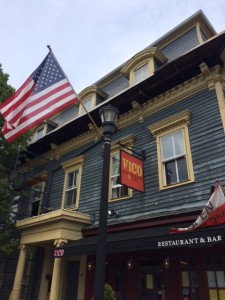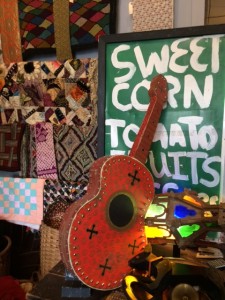My first clue was this goofy-looking, very dated, blue-and-white parking sign showing a smiling whale with wheels. We were figuring out where we could legally park and my initial thought was “What the hell is there a whale sign doing in the Catskills???”
Goes to show what I know. Turns out Hudson, New York, was an old whaling town. And I call myself a New Yorker.
There are dozens of towns dotting the Hudson Valley, that fuzzy green space north of the Big Apple that has some of upstate New York’s rust beltness with a touch New Englandy pastoral independence. I’d never heard of Hudson, New York, until we wanted some custom-made furniture and after Googling “Hudson Valley cabinet makers” I found Jason, a tree-to-table artisan who maintains a shop called Fern Handcrafted on Warren Street in Hudson.
“What’s with the whale signs?” I asked him after drooling over all the beautiful stuff he makes from trees.
“This was an old whaling town,” he replied.
And I wondered, but didn’t want to say aloud, “Shouldn’t the Atlantic Ocean be involved?” Mystic, Connecticut, was an old whaling town. Nantucket was an old whaling town. But a riverside community a hundred miles from open ocean and just 30 miles from skiing? I had to know more.
Long before Brooklyn hipsters moved north and the farm-to-fork scene became a scene, Hudson was the first Hudson Valley whaling town in the late 18th century, later followed by Poughkeepsie and Newburgh, all towns that hug the Hudson River and now siphon commuters south by train to offices in Manhattan. In 1774, when the Continental Congress decided to break off trade with Britain, Britain retaliated by taking over the colonies’ primary seaports, New York and Boston. That choked off whaling, which was in full swing after someone off the coast of Nantucket harpooned a sperm whale in 1712 and realized the commercial potential of what he just did.
Fast forward to 1783; two Nantucket brothers—one being an experienced whaler—went property-shopping around the Northeast for a place to keep the whale business afloat, perhaps not confident that the Revolutionary War would actually end that same year after eight long years. The two men, with the stout New England names Seth and Thomas Jenkins, went upriver about 120 miles from Manhattan, and stopped at what was then called Claverack Landing, a farming town of about 150 people. What caught the Brothers Jenkins’ eyes were two bays deep enough to accommodate whaling ships. Two years later, the brothers literally drew out a planned city that could support the whaling industry, and renamed Claverack Landing, Hudson. By 1790, Hudson boasted a population of about 2,500.
Around this time, Boston and New York were beginning to recover from the Revolutionary War and ports hummed with merchant ships again. Hudson continued to contribute, dragging dead whales upriver that had bled out along the way, and processing them in the valley refineries for oil, blubber, meat and bones for corsets. Whaling remained a vibrant industry for those first few decades of the nineteenth century and then kerosene began to take over in the 1840s, which is about when the Hudson Valley whaling companies stopped sending out ships. So now there was a town, and no industry, a story that would hit upstate New York farm towns over and over again for decades to come.
Two hundred thirty years after taking its current name, what is the city of Hudson doing now? It has a population of just under 7,000, which was its population at around 1850 when whaling was sputtering out. But its population is now more urban refugees with a fair share of Brooklyn hipster transplants, including my furniture guy, who decided he needed more space to carve sixteen-foot conference tables that he ships off to places like Miami and Japan, not to mention an easier time sourcing the trees that make the furniture that appears in Elle Decor and The New York Times.
Guys like Jason restore my faith in small town America. And walking Hudson, I could see it. Outside, a thriving downtown lined with independent businesses, some painted a bright tangerine or a soft, buttery yellow or a deep hue of claret. Everything was old yet still full of purpose; one faded brick building in need of a paint job dated from 1805 and had served as a jail, a meeting house and a printing shop. Also outside: people not beeping at me to get the hell out of the way, which happens in suburban New Jersey, a vortex of patience and civility.
Inside these historic Hudson buildings, decorated tin ceilings, which were popular during the Victorian era, and countless shelves of fair trade goods or homemade goods or things designed to make you feel good, to reassure you that not everything was manufactured in China or assembled in the cheapest way possible. Hudson epitomized the shop local movement. There were tea shops, ice cream parlors, Jason, restaurants, books and tons of antiques—a word losing its shape. When I was a kid going on family vacations across New England, including Mystic, Conn., “antique” meant something fancy made in the 1800s; now it seems to mean anything not recently bought on Amazon. Hudson had several of these shops pushing “vintage” and “antique” wares, objects that too often looked like the same things your aunt wasn’t able to unload at a garage sale, such as a giant papier-mâché taxi. Yet even Hudson proprietors organized their junk in thoughtful, visually alluring ways, and Mike and I were both charmed.
We didn’t have time to walk down to the river front or explore further because we had to get back on the road, but we’ll be back to pick up our bathroom vanity from Jason, and, likely place another order with him. And maybe I’ll snap a photo of that whale sign that sparked it all, an item that truly looked like it came from an “antique” store. Our relationship with Hudson is just beginning.
But what does all this mean? Ok, so I learned that a rustic town with urban flair had a brief, but colorful past in the whaling industry that came to be because of the Revolutionary War. So what? Well, this day trip got me thinking again about America, because America is a strange place, really several mini-nations recognizing the same flag. Before our drive to Hudson, what it means to be an American when America was pretty new had weighed on me, because it seems very different than what it means to be American now. The Northeast feels completely different from Texas. The West Coast feels completely from the Midwest. And then there’s Hawaii and Alaska. Different is good. National identities should evolve with the times, but there’s an undercurrent of anger and narcissism that’s palpable across America that troubles me. Racism, rampant obesity and sedentary living, the have-and-have-not socioeconomic subcultures, constant legal challenges against Obamacare, chronic political bipolarity, incessant consumerism, an inflammatory American media allowing no room for more nuanced points of view or discussions because it just doesn’t make for good TV (CNN and FOX are equally guilty here). All have me thinking what it would be like to perch somewhere else for a while.
I’ve been reading up about the Revolutionary War lately, and it wasn’t a picnic then either—obviously racism, poverty, starvation. Infections we consider innocuous today, such as flu and strep, sent families to their graves. I also read that George Washington had dysentery so frequently that he sat on a pillow when on horseback, something that freaked out his subordinates because it heightened their leader when he sat on the saddle—and he was already a tall guy—making him an easier target for anyone armed who disagreed with him.
But was there this anger and narcissism I sense now? Ambiguity, yes. History books teach American kids that everyone grabbed the flag and told Britain where to stick it, but we all know it’s more complicated than that, that people struggled with their choices, that many felt terrified of losing Britain, that many questioned colonial leadership. Yet, that entrepreneurial American attitude persisted even when choices remained unclear. You don’t get on a boat and strike out for the unknown unless you have an entrepreneurial spirit; it’s in America’s DNA. This can-do attitude has weathered wars and economic setbacks, and was on full display in Hudson this past weekend. What got lost along the way over the centuries, I could not say, but walking Hudson and reading about the formation of this community, I discovered that the best of what it meant to be American flourished there and still does. All that promise, not just capital potential in whaling, but in developing an identity, influenced the greater good and influenced a community and a culture. It was there in Hudson and remains there, though as I roadtrip the United States more and more, I question whether it’s everywhere.







